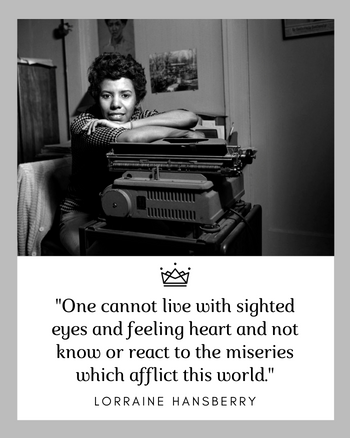About Lorraine Hansberry: The Playwright of a Raisin in the Sun

By Liz Armstrong
Lorraine Hansberry was the first African American woman to write a play produced on Broadway. A Raisin in the Sun opened at the Ethel Barrymore Theatre on Broadway in March, 1959 and was extremely successful.
It tells the story of the proud Younger family as they grapple with different definitions of the American dream and how to achieve it, while battling racial discrimination, financial pitfalls, and relationship challenges. These threaten to pull the family apart and push their dreams out of reach.
Hansberry won a Drama Desk Award for her debut play. After receiving this award, she sat down for an interview in her home in Chicago.
“I believe that one of the most sound ideas in dramatic writing is that in order to create something universal, you must pay very great attention to the specific,” Hansberry said.
But let’s backtrack before diving into Hansberry’s success as a playwright. Born May 19, 1930 in Chicago Illinois, Hansberry proved to be passionate about writing at a young age. In high school, she was drawn to theater.
The playwright attended the University of Wisconsin from 1948-1950 and was briefly enrolled at the Art Institute of Chicago and Roosevelt University. To focus on her writing and further her skills, Hansberry also studied at the New School for Social Research. While attending this school, Hansberry wrote for the Pan-Africanist newspaper Freedom, working alongside intellectuals Paul Robeson and W. E. B. Dubois.
A Raisin in the Sun tells the story of a lower-class African-American family set in 1950s Chicago, so Hansberry took experience from her own life – depicting the struggles this family faced in a realistic (and heartbreaking) way. This is reflected in a letter Hansberry wrote.
“As one raised in a subculture experience (I am a Negro) where those within were and are forever lecturing to their fellows about how to appear acceptable to the dominant social groups, I know something about the shallowness of such a view in and of itself,” Hansberry wrote.
“What ought to be clear is that one is oppressed or discriminated against because one is ‘different’, not ‘wrong’ or ‘bad.’ This is perhaps the bitterest of the entire pill,” Hansberry continued.
A Raisin in the Sun was later adapted into a film, released in 1961, starring Claudia McNeil and Sidney Poitier. At age 29, Hansberry received the New York Drama Critics Circle Award, the youngest playwright to do so. She was nominated for the Tony Award for Best Play.
Although A Raisin in the Sun was the first play she wrote, it wasn’t the only one. In 1964, she penned The Sign in Sidney Brustein’s Window, a play following the story of a man named Sidney, focusing especially on his struggles in Bohemian culture. It included themes of race, suicide, homosexuality, and coping and navigating life. Other works included The Drinking Gourd (1960) and What Use are Flowers? (1960).
In 1963, Hasberry met with Attorney General Robert F. Kennedy, a meeting set up with the famous American writer James Baldwin. The meeting was an attempt to improve race relations in the United States, resulting in a positive turning point in Kennedy’s attitude toward the Civil Rights Movement.
Hansberry passed away at the young age of 34 on January 12, 1965 from pancreatic cancer. Of her death, James Baldwin said, “It is not at all far-fetched to suspect that what she saw contributed to the strain which killed her, for the effort to which Lorraine was dedicated is more than enough to kill a man.”
Four years later, Robert Nemiroff, Hasberry’s husband of 11 years, produced To Be Young, Gifted, and Black on Broadway. It was the longest running Off-Broadway play of the 1968/69 season. A selection of Hansberry’s writings, the play was adapted and published in book form in 1970.
Through her writings, Hansberry explored her identities as a writer, lesbian, feminist, black woman, and part of a heterosexual marriage. Her works challenged themes of segregation, racism, oppression of homosexuality and focused on African struggles for liberation and their impact on the world.
Of Hansberry, Martin Luther King, Jr. said, “Her creative ability and her profound grasp of the deep social issues confronting the world today will remain an inspiration to generations yet unborn.”









